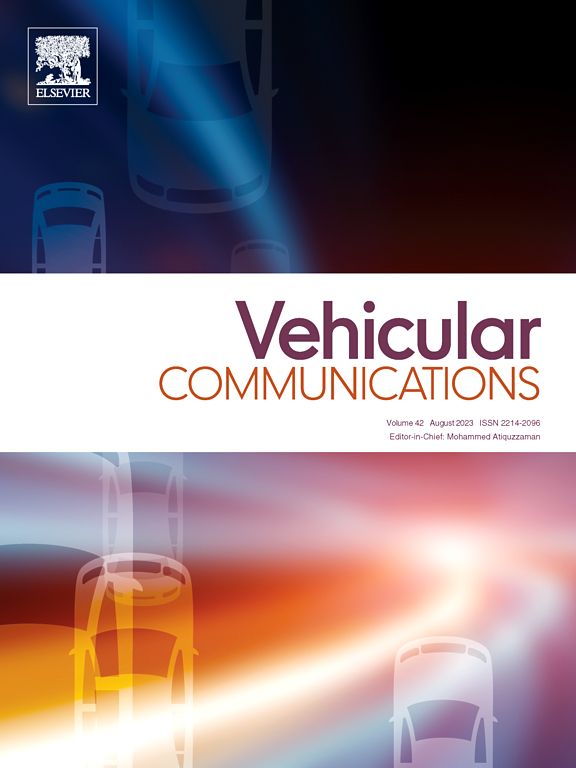Impact of sea cluttering and wave shadowing on U2S MIMO channel model incorporating UAV-ship 6D motion in maritime environments
IF 6.5
2区 计算机科学
Q1 TELECOMMUNICATIONS
引用次数: 0
Abstract
Unmanned aerial vehicles (UAVs) are increasingly integrated into maritime communication systems, presenting unique challenges due to complex maritime scenario. By considering six-dimensional (6D) motion of both UAV and ship alongside sea cluttering and wave shadowing phenomena, this paper presents a novel non-stationary 6D geometry-based multiple-input multiple-output (MIMO) channel model for UAV to ship (U2S) communications for maritime scenario. Besides, the dynamic interactions between UAV and ship motions and maritime environments are also described in the proposed model. The time-variant channel coefficient and channel parameters like, path loss (PL), shadow fading (SF), Doppler frequencies, wave shadowing, sea cluttering, time-variant distances, time-variant delay, time-variant power, time-variant angles, are derived and analyzed thoroughly in this proposed method. Additionally, the theoretical and statistical properties like, probability density function (PDF), autocorrelation function (ACF), level crossing rate (LCR), Doppler power spectral density (DPSD), and signal to clutter noise ratio (SCNR) are investigated with the effect of sea cluttering and wave shadowing. Finally, the validation of the channel model and its theoretical derivations highlight its suitability for evaluating and designing U2S communication systems in maritime environments. The suggested model can be useful for improving U2S communication systems, to enhance reliability and performance in maritime communication environments.海洋杂波和波浪阴影对海洋环境下包含无人机舰船6D运动的U2S MIMO信道模型的影响
无人驾驶飞行器(uav)越来越多地集成到海上通信系统中,由于复杂的海上场景,提出了独特的挑战。考虑无人机和船舶在海上杂波和波浪阴影现象下的六维(6D)运动,提出了一种基于非平稳6D几何的无人机对船(U2S)通信的新型多输入多输出(MIMO)信道模型。此外,该模型还描述了无人机与船舶运动和海洋环境之间的动态相互作用。对时变信道系数和信道参数如路径损耗(PL)、阴影衰落(SF)、多普勒频率、波影、海杂波、时变距离、时变时延、时变功率、时变角度等进行了推导和分析。此外,在海面杂波和波浪阴影的影响下,研究了该系统的概率密度函数(PDF)、自相关函数(ACF)、平交率(LCR)、多普勒功率谱密度(DPSD)和信杂波噪声比(SCNR)等理论和统计特性。最后,通道模型及其理论推导的验证突出了其在海洋环境中评估和设计U2S通信系统的适用性。所建议的模型可用于改进U2S通信系统,以提高海上通信环境中的可靠性和性能。
本文章由计算机程序翻译,如有差异,请以英文原文为准。
求助全文
约1分钟内获得全文
求助全文
来源期刊

Vehicular Communications
Engineering-Electrical and Electronic Engineering
CiteScore
12.70
自引率
10.40%
发文量
88
审稿时长
62 days
期刊介绍:
Vehicular communications is a growing area of communications between vehicles and including roadside communication infrastructure. Advances in wireless communications are making possible sharing of information through real time communications between vehicles and infrastructure. This has led to applications to increase safety of vehicles and communication between passengers and the Internet. Standardization efforts on vehicular communication are also underway to make vehicular transportation safer, greener and easier.
The aim of the journal is to publish high quality peer–reviewed papers in the area of vehicular communications. The scope encompasses all types of communications involving vehicles, including vehicle–to–vehicle and vehicle–to–infrastructure. The scope includes (but not limited to) the following topics related to vehicular communications:
Vehicle to vehicle and vehicle to infrastructure communications
Channel modelling, modulating and coding
Congestion Control and scalability issues
Protocol design, testing and verification
Routing in vehicular networks
Security issues and countermeasures
Deployment and field testing
Reducing energy consumption and enhancing safety of vehicles
Wireless in–car networks
Data collection and dissemination methods
Mobility and handover issues
Safety and driver assistance applications
UAV
Underwater communications
Autonomous cooperative driving
Social networks
Internet of vehicles
Standardization of protocols.
 求助内容:
求助内容: 应助结果提醒方式:
应助结果提醒方式:


